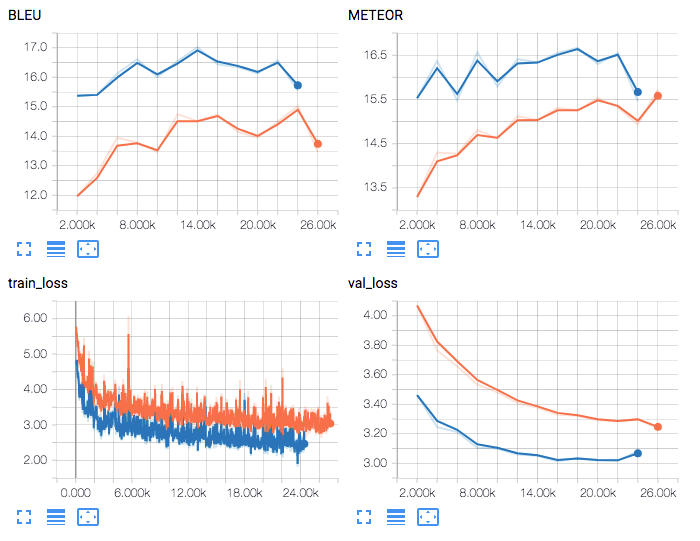This is the PyTorch fork of nmtpy, a sequence-to-sequence framework which was originally a fork of dl4mt-tutorial.
The core parts of nmtpytorch depends on numpy, torch and tqdm.
nmtpytorch is developed and tested on Python 3.6 and will not support
Python 2.x whatsoever.
We ship subword-nmt and METEOR
paraphrase files as submodules in order to track their updates when
necessary. Besides these METEOR v1.5 JAR, multi-bleu.perl and COCO
evaluation tools cocoeval are directly included within the source tree.
Run the following command to recursively fetch the repository including those submodules:
git clone --recursive https://github.com/lium-lst/nmtpytorch.git
Install using develop mode:
python setup.py develop
A sample NMT configuration for
English-to-German Multi30k is provided which covers nearly all of the [train]
and [model] specific options to NMT.
After creating a configuration file for your own dataset that suits your need, you can run the following command to start training:
nmtpy train -C <config file>
It is possible to override any configuration option through the command-line:
nmtpy train -C <config file> train.<opt>:<val> model.<opt>:<val> ...
The initial release aims to be (as much as) feature compatible with respect
to the latest nmtpy with some important changes as well.
If you would like to monitor training progress, you may want to install tensorboard-pytorch. Note that you will also need to install the actual TensorBoard server which is shipped within Tensorflow in order to launch the visualization server.
Once the dependencies are installed, you need to define a log directory for
TensorBoard in the configuration file of your experiment to enable
TensorBoard logging. The logging frequency is the same as terminal logging
frequency, defined by train.disp_freq option (default: 30 batches).
[train]
..
tensorboard_dir: ~/tb_dir
Instead of shipping several tools for training, rescoring, translating, etc.
here we provide a single command-line interface nmtpy which implements
three subcommands train, translate and resume.
nmtpy train
usage: nmtpy train [-h] -C CONFIG [-s SUFFIX] [overrides [overrides ...]]
positional arguments:
overrides (section).key:value overrides for config
optional arguments:
-h, --help show this help message and exit
-C CONFIG, --config CONFIG
Experiment configuration file
-s SUFFIX, --suffix SUFFIX
Optional experiment suffix.
nmtpy translate
usage: nmtpy translate [-h] [-n] -s SPLITS [-b BATCH_SIZE] [-k BEAM_SIZE]
[-m MAX_LEN] [-p] [-u] [-d DEVICE] [-e]
models [models ...]
positional arguments:
models Saved model/checkpoint file(s)
optional arguments:
-h, --help show this help message and exit
-n, --disable-filters
Disable text filters given in config.
-s SPLITS, --splits SPLITS
Comma separated splits to translate
-b BATCH_SIZE, --batch-size BATCH_SIZE
Batch size for beam-search
-k BEAM_SIZE, --beam-size BEAM_SIZE
Beam size for beam-search
-m MAX_LEN, --max-len MAX_LEN
Maximum sequence length
-p, --avoid-double Suppress previous token probs
-u, --avoid-unk Suppress <unk> generation
-d DEVICE, --device DEVICE
Select GPU device(s)
-e, --ensemble Enable ensembling for multiple models.
The INI-style experiment configuration file format is slightly updated to allow for future multi-task, multi-lingual setups in terms of data description.
Model-agnostic options are defined in [train] section while the options
that will be consumed by the model itself are defined in [model].
An arbitrary number of parallel corpora with multiple languages can be defined
in [data] section. Note that you need to define at least
train_set and val_set datasets in this section for the training and
early-stopping to work correctly.
We recommend you to take a look at the provided sample configuration to have an idea about the file format.
We still provide a single, model-agnostic mainloop that handles everything
necessary to train, validate and early-stop a model.
You just need to create a new file under nmtpytorch/models and define a
class by deriving it from nn.Module. The name of this new class will be the
model_type that needs to be written inside your configuration file. The next
steps are to:
- Parse model options passed from the configuration file in
__init__() - Define layers inside
setup(): Eachnn.Moduleobject should be assigned as an attribute of the model (i.e.self.encoder = ...) in order for PyTorch to work correctly. - Create and store relevant dataset objects in
load_data() - Define a
get_iterator()method to obtain a dataset-specific iterator depending on train/dev and loss/beam-search variants. - Define
compute_loss()which takes a data iterator and computes the loss over it. This method is used for dev set perplexities. - Define
aux_loss()where you may want to define an additional loss term. Return just0if you do not want to use it. - Define
forward()which takes a dictionary with keys as data sources and returns the batch training loss. This is the method called from themainloopduring training. - Define
beam_search()which takes a data iterator and generates hypotheses using beam search. The default implementation inNMTis a batched GPU version.
Feel free to copy the methods from NMT if you do not need to modify
some of them.
Currently we only provide a Conditional GRU NMT implementation with Bahdanau-style attention in decoder.
NOTE: We recommend limiting the number of tokens in the target vocabulary
by defining max_trg_len in the [model] section of your configuration file
to avoid GPU out of memory errors for very large vocabularies. This is caused
by the fact that the gradient computation for a batch with very long sequences
occupies a large amount of memory unless the loss layer is implemented differently.


